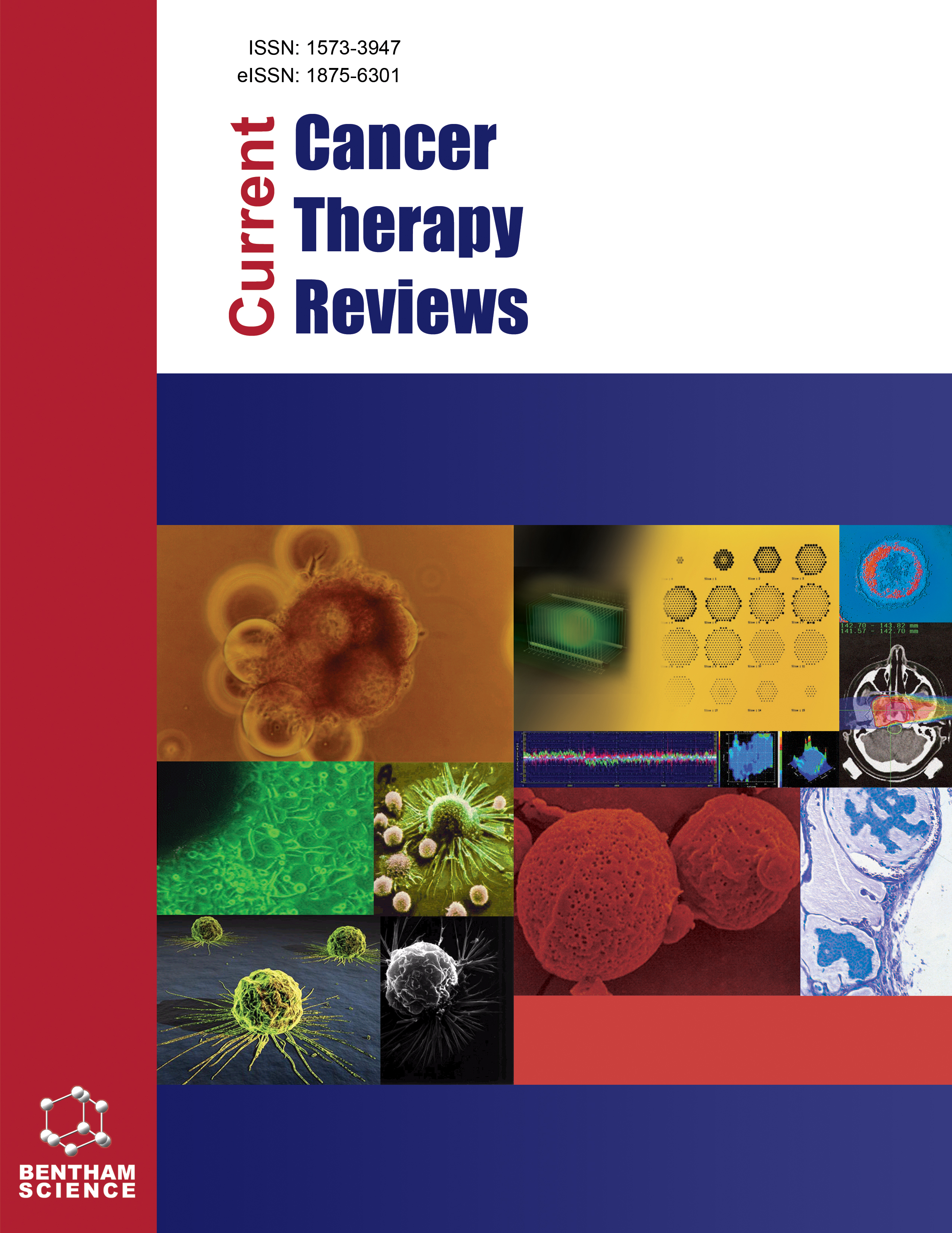- Home
- A-Z Publications
- Current Cancer Therapy Reviews
- Previous Issues
- Volume 21, Issue 2, 2025
Current Cancer Therapy Reviews - Volume 21, Issue 2, 2025
Volume 21, Issue 2, 2025
-
-
Cross-talk between Enzyme Micellar Systems and Tumor Microenvironment: A Strategy for Tackling Cancer
More LessCancer therapy has evolved beyond targeting malignant cells alone, recognizing the pivotal role of the tumor microenvironment (TME) in disease progression. Enzyme micellar systems, a subset of nanomedicine, offer a cutting-edge approach by exploiting the intricate interplay between therapeutic delivery and the TME. Engineered to respond to enzymatic cues, these systems enable targeted drug delivery, controlled rel Read More
-
-
-
Electrospun Biopolymer as a Therapeutic Agent in Cancer Treatment
More LessAuthors: Prachi Rustagi, Swati Verma, Rishabha Malviya and Shuchita MishraThis article highlights the therapeutic use of electrospun biopolymers in cancer treatment. An overview of cancer and electrospun is presented at the beginning. The reasons for electrospinning, the elements that influence electrospinning, and the most recent breakthroughs in the utilization of electrospun nanofibers in cancer research are then explored. The insertion of drugs, managing emission kinetics, alignment and proper Read More
-
-
-
Biological Potential and Therapeutic Effectiveness of a Polyethylene Alkyne Class Phytochemical ‘Atractylodin’ in Medicine for the Treatment of Cancer and other Human Complications
More LessAuthors: Dinesh Kumar Patel and Kanika PatelBackgroundAtractylodes lancea Thunb. (Asteraceae) is a commonly used medicinal plant for gastric and appetite-associated complications in traditional Chinese medicine. The rhizome of Atractylodes lancea has been widely used for the treatment of human complications. Atractylodin has anti-angiogenic, anti-cancer, anti-inflammatory, anti-microbial, anti-pyretic and anti-hypertensive potential in medicine. Nano-formulatio Read More
-
-
-
The Amelioration of Side Effects Associated with Chemotherapy
More LessAuthors: Priya Agrawal and Mayank JainChemotherapy is a multimodal strategy that entails very complicated regimens to treat cancer. Despite the better effectiveness and increased longevity afforded by chemotherapy, its side effects and long-term sequelae continue to be significant causes of worry for both physicians and patients. The patients often experience nausea, vomiting, cardiac toxicity, lung toxicity, hepatotoxicity, nephrotoxicity, etc., as adverse d Read More
-
-
-
An Update on the Treatment Strategy for Non-small Cell Lung Cancer: A Current Scenario and Future Perspective
More LessAuthors: Rahini Rajendran and Jayanthi MathaiyanNon-small cell lung cancer (NSCLC) is a ubiquitous form of lung cancer. Most patients already have metastasis at the time of diagnosis. Chemotherapy and radiotherapy are widely used to treat the early stages of NSCLC, but cancer relapses are common, and the mortality rate is also high. Hence, there is a definite need for newer and advanced therapies to control the recurrence and metastasis of NSCLC. Many cl Read More
-
-
-
Recent Advancement in Nanotechnological Approaches for Increasing the Effectiveness of Herbal Drugs in the Treatment of Colorectal Cancer
More LessAuthors: Archana and Rohitas DeshmukhColorectal cancer (CRC) ranks as the third most prevalent cancer type and the second leading cause of cancer-related deaths globally. The mortality rate from colon cancer has seen a significant increase, correlating with the widespread adoption of Western dietary habits and lifestyles. Medicinal plants, notably those containing functional phytochemicals like polysaccharides, exhibit anti-tumor and anti-apoptotic properti Read More
-
-
-
Anti-cancer Potential of Phytoflavonoidal Drugs against Gynecological Cancer
More LessAuthors: Kavita Sangwan and Parveen Kumar GoyalBackgroundFlavonoids, one of the major bioactive constituents of herbal drugs, have been scientifically reported to possess diverse therapeutic potentials such as anticancer, immunomodulatory, neuroprotective, cardioprotective, antioxidant, etc. This manuscript enlightens the anticancer potential of traditional herbal flavonoids in gynecological cancer i.e., is one of the major life-threats in women.ObjectiveThis manuscript i Read More
-
-
-
Antioxidant and Chemopreventive Potential of Uraria picta Root Extracts against DMBA/croton Oil Induced Skin Carcinogenesis in Mice
More LessAuthors: Jai P. Kadian and Madan L. KaushikIntroductionSkin cancer is the fifth most common cancer and is a serious concern to public health and the economy. Although, various treatment strategies are available but have several undesirable side effects. To combat these drawbacks, phytoconstituents or herbs can be the best choice. Uraria picta (prishniparni) is a potential herb used in various herbal formulations, important of which is Dasmularishta.MethodsThus, the Read More
-
-
-
Borderline Brenner Tumor of the Ovary in a Postmenopausal Woman: A Rare Case with Concomitant Endometrial Hyperplasia and Endocervical Polyp
More LessAuthors: Naina Kumar, Immanuel Pradeep, Annapurna Srirambhatla, K. Poojitha and Mishu ManglaIntroductionBordeline Brenner tumors of the ovary are rare tumors accounting for 2% of all ovarian tumors and are characterized by the presence of papillary structures covered with transitional epithelium without or minimal stromal invasion.Case PresentationIn the present case report a 60-year-old postmenopausal woman presented with complaints of lower abdominal pain and a right ovarian mass of 4x5cm, which was dia Read More
-
Volumes & issues
-
Volume 21 (2025)
-
Volume 20 (2024)
-
Volume 19 (2023)
-
Volume 18 (2022)
-
Volume 17 (2021)
-
Volume 16 (2020)
-
Volume 15 (2019)
-
Volume 14 (2018)
-
Volume 13 (2017)
-
Volume 12 (2016)
-
Volume 11 (2015)
-
Volume 10 (2014)
-
Volume 9 (2013)
-
Volume 8 (2012)
-
Volume 7 (2011)
-
Volume 6 (2010)
-
Volume 5 (2009)
-
Volume 4 (2008)
-
Volume 3 (2007)
-
Volume 2 (2006)
-
Volume 1 (2005)
Most Read This Month
Article
content/journals/cctr
Journal
10
5
false
en


